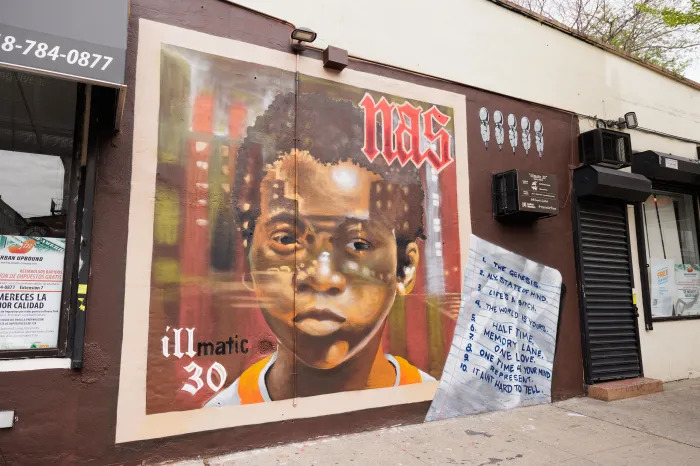Balanced on wooden supports in Lisa DiClerico’s Long Island City studio was an 18th century European mirror. The 10-foot-tall relic suffered damages during a fire. Its previously ornate, gilded edges were left charred. The mirror’s sculpted glass, once reflecting the image of a figure now long gone, was coated in layers of soot. Many ornamental leaves snapped off during the blaze, leaving an enormous, historic puzzle.
The mirror was in pieces. DiClerico put it back together.
The restorative artist repairs and conserves antique furnishings and fixtures, rejuvenating vestiges from the past to their original splendor.
Growing up in Staten Island, DiClerico acquainted herself with art from an early age. Her grandmother kept an in-home studio where she taught DiClerico oil painting. Her great-grandfather excelled in sculpture, many of his creations still in DiClerico’s possession.
She attended the Fashion Institute of Technology in Manhattan, majoring in fine arts before switching to the school’s restoration program. When she graduated in 1999, DiClerico was unsure of her future.
“I wasn’t convinced that I wanted to be a restorer,” she said. “I wanted to paint and sculpt every day. I wanted a really hands-on art job with materials and techniques.”
 DiClerico became captivated by the materials and techniques involved with restoration, mixing her own paints, pigments and glues. She adored learning the history behind the design and origins of pieces.
DiClerico became captivated by the materials and techniques involved with restoration, mixing her own paints, pigments and glues. She adored learning the history behind the design and origins of pieces.
After graduating, DiClerico enrolled in a continuing studies program where she assisted with the restoration of a 13th century fresco in Florence, Italy. She said the experience furthered her perspective on the world of restoration.
After returning from Florence, DiClerico spent two years working with a studio furniture maker, exploring more deeply the techniques of woodworking while learning about the material. The tactile experience provided learning beyond what DiClerico felt she could access in a classroom.
DiClerico left the woodshop, going to work at S. Porter, a studio that focuses on restoration and conservation. To make extra money, she waited tables in restaurants. While waitressing at SoHo hotspot Giorgione, she met her current long-term partner, Alex, who was the restaurant’s executive chef.
As work became steadier, DiClerico left her side job and set up her own studio – a space she shares with a girlfriend from college who is also a restorative artist.
While DiClerico does not specialize in museum-type conservation, she believes staying true to the piece’s original design is imperative. DiClerico only uses antique methods and materials, handcrafting her own shellacs and avoiding contemporary paint. The key to conservation, she says, is reversibility. Anything she does should theoretically have the ability to be undone.
“Over time, if the color starts to oxidize or if 100 years from now someone wants to redo the piece, my additions can be taken out without any damage to the original material,” she said.
Various jobs can take anywhere from half a day to several weeks and differ greatly in need – a work perk DiClerico says keeps her on point and forces her to use creative problem solving. Most of the pieces come from private collectors who purchased them at auctions. She recently refurbished an art deco style child’s chair, recovered from the SS Normandie – a transatlantic luxury liner seized during World War II.
Several years ago, Alex decided to open his own restaurant, convinced by DiClerico to set up shop in Long Island City. Over a year, the couple designed and renovated the space, using found objects from a friend’s 20th century Flushing home before it was knocked down. Salvaged wooden doors became the baseboards for the restaurant’s bar and a gorgeous wrought-iron gate now adorns the eatery’s entryway.
“It was the universe saying ‘here’s a house full of really cool stuff that’s just going to go in the garbage,’” said DiClerico.
July marks two years of the couple as co-owners of LIC Market. Alex spends all day in the kitchen while DiClerico curates the store’s art, keeping the interior fresh with work from budding artists.
“I really love this neighborhood, so it’s neat to have created the place we wanted and to get such positive feedback from people who live here and people who commute too,” said DiClerico. “It’s really rewarding.”
DiClerico commented on Long Island City’s uncommon sense of community and the joy she feels from providing a place that brings people together.
In an effort to collaborate with other artists, DiClerico helped foster and sits on the board of the Artisan’s Guild of America – a network of creatives she hopes will expand across the country.
“We need to preserve these things and raise awareness,” said DiClerico. “They can disappear in this rapidly-changing and evolving world.”






























